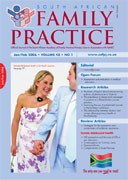A qualitative study on the relationship between doctors and nurses offering primary health at KwaNobuhle (Uitenhage).
Keywords:
Doctor-nurse relationship, primary health care, public-private interface
Abstract
Background: Primary health care, which was the domain of the nursing profession, was popularised by the introduction of free health services by the South African legislature. In addition, the district health system was developed with the aim of keeping people healthy by creating small management systems adapted to cater for local needs. These measures increased public access to healthcare centres, leading to an increased workload at primary health level. The government, being a large organisation, relies on groups that include doctors and nurses to accomplish its goals, and the effectiveness of these groups plays a major role in determining the effectiveness of the overall organization. “The nurse has an ethical responsibility in the interest of the welfare of her patient to be a loyal and competent colleague to the doctor. The nurse and the doctor must be able to rely on each other. Mutual respect is vital. Nurses have dependent, independent and interdependent roles in their interaction with doctors, and both professions should embrace the Patient’s Rights Charter, which requires a good standard of practice and care of patients. International journals have published numerous letters citing doctor-nurse disagreements in their interactions. Historically, the doctor-nurse relationship is an unequal one characterised by the dominance of the doctor, with nurses assuming a position of lower status and dependence on physicians. One qualitative study showed that nurses perceive the quality of communication with doctors as being poor. Lack of teamwork in the relationship resulted from different expectations and a confusion of roles. Both professions have however demonstrated a willingness to promote teamwork in hospitals. A journal review on interventions to promote collaboration between nurses and doctors showed positive gains once collaboration was embraced. Method: This was a descriptive qualitative study in which the experiences of Kwa-Nobuhle general practitioners and professional nurses were explored. An equal number of nurses and doctors (five each) were purposefully selected, for the free-attitude interviews used for data collection. All interviews were analysed using the thematic analysis method. Themes were integrated into a single model. Results: Majority of respondents experienced a relatively good relationship. The positive factors were balanced by negative experiences by almost all respondents. The positives were personal growth, efficiency at work, opportunity for education and learning at the primary healthcare level. The negatives were doctors’ inconsistent clinic visits, role confusion (with doctors being confused with policymakers), dominance of the doctor in the relationship, and lack of doctor-nurse forums for communication, with subsequent suspicion and tension. The impact of the conflicts was neutralised by the track record of the relationship and the behaviour of the participants towards each other. Conclusion: This study showed congruence with other studies, where the doctor-nurse relationship was influenced by a power differential, collaboration, role confusion, impact of the respondents’ competence, the significance of recognising the nurses’ hierarchy and continuity of the care they provide at the primary health level. Maximum variation, strict admission criteria and data validation through a member check addressed issues of bias in this study. The exploration of relationships is a sensitive issue and a different methodology may produce different results. The environment where this research was conducted may differ from others, leading to discrepancies in findings. Future research could further focus on team building and the essential elements to sustain the doctor-nurse-patient team. (SA Fam Pract 2006;48(1): 17)
Published
2006-02-20
Section
Original Research
By submitting manuscripts to SAFP, authors of original articles are assigning copyright to the South African Academy of Family Physicians. Copyright of review articles are assigned to the Publisher, Medpharm Publications (Pty) Ltd, unless otherwise specified. Authors may use their own work after publication without written permission, provided they acknowledge the original source. Individuals and academic institutions may freely copy and distribute articles published in SAFP for educational and research purposes without obtaining permission.

